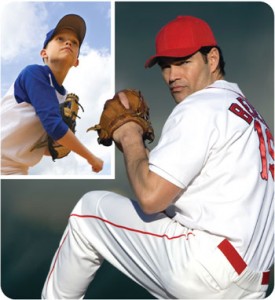 Overhand throwing places extremely high stresses on the elbow. In baseball pitchers and other throwing athletes, these high stresses are repeated many times and can lead to serious overuse injury. Although throwing injuries in the elbow most commonly occur in pitchers, they can be seen in any athlete who participates in repetitive overhand throwing.
Overhand throwing places extremely high stresses on the elbow. In baseball pitchers and other throwing athletes, these high stresses are repeated many times and can lead to serious overuse injury. Although throwing injuries in the elbow most commonly occur in pitchers, they can be seen in any athlete who participates in repetitive overhand throwing.
Flexor Tendinitis
Repetitive throwing can irritate and inflame the flexor tendons where they attach to the humerus bone on the inner side of the elbow.
Ulnar Collateral Ligament (UCL) Injury
The ulnar collateral ligament (UCL) is the most commonly injured ligament in throwers. Injuries of the UCL can range from minor damage and inflammation to a complete tear of the ligament. This is also known as the “Tommy John” injury.
Valgus Extension Overload (VEO)
During the throwing motion, the olecranon and humerus bones are twisted and forced against each other. Over time, this can lead to wear on the elbow cartilage and bone spur formation.
Stress Fracture
Stress fractures occur when muscles become fatigued and are unable to absorb added shock. Eventually, the fatigued muscle transfers the over-load of stress to the bone, causing a tiny crack called a stress fracture.
Ulnar Neuritis
In throwing athletes, the ulnar (or “funny bone”) nerve is stretched repeatedly. This stretching can lead to irritation of the nerve, a condition called ulnar neuritis. This can cause pain and numbness that radiates from the inside of the elbow down to the small finger.
In many of these elbow conditions, pain will resolve when the athlete stops throwing. In baseball pitchers, rate of injury is highly re-lated to the number of pitches thrown, the number of innings pitched, and the number of months spent pitching each year. In most cases, treatment for throwing in-juries in the elbow begins with a short period of rest. Additional treatment options may include physical therapy, changing throwing mechanics, anti-inflammatory medications and icing.
If painful symptoms are not relieved by nonsurgical methods, and the athlete desires to continue throwing, surgical treatment may be considered.
Elbow Arthroscopy is a common way of treating elbow joint problems. During arthroscopy, the surgeon inserts a small camera, called an arthroscope, into the elbow joint. The camera displays pictures on a television screen, and the surgeon uses these images to guide miniature surgical instruments to address the problems.
Athletes who have an unstable or torn UCL, and who do not respond to nonsurgical treatment, are candidates for surgical ligament reconstruction. This surgical procedure is referred to as “Tommy John surgery” by the general public, named after the former major league pitcher who had the first successful surgery in 1974. Today, UCL reconstruction has become a common procedure, helping professional and college athletes continue to compete in a range of sports.
The best way to treat elbow injuries is to prevent them. Recent re-search has focused on identifying risk factors for elbow injury and strategies for injury prevention. Proper conditioning, technique, and recovery time can help to prevent throwing injuries in the elbow. In the case of younger athletes, pitching guidelines regarding rest, number of pitches per game and week, as well as type of pitches thrown, have been developed to protect children from injury.
Our elbow and sports medicine specialists at The Orthopaedic Clinic have years of experience and specialized training in treating various elbow disorders. If you or someone you know if suffering from elbow problems, let our team of experts evaluate you and get you back to throwing without pain!
